und Wörterbuch
des Klassischen Maya



Pecking a New Stela: A Reading Proposal for Sign 1927 as T’OJ
Research Note 26
DOI: https://doi.org/10.20376/IDIOM-23665556.22.rn026.en
Nikolai Grube (Rheinische Friedrich-Wilhelms-Universität, Bonn)
Elisabeth Wagner (Rheinische Friedrich-Wilhelms-Universität, Bonn)
Christian Prager (Rheinische Friedrich-Wilhelms-Universität, Bonn)
Marie Botzet (Rheinische Friedrich-Wilhelms-Universität, Bonn)
Guido Krempel (Rheinische Friedrich-Wilhelms-Universität, Bonn)
Quirigua Stela C is among the best-known monuments of the Classic Maya. This is due to the much-cited account of the creation of the present world, inscribed on the east side of the monument (Freidel, Schele and Parker 1993; Looper 1995, 2003). From a historical perspective, however, the text on the opposite west side is also of interest, reporting on the reign of King Tutum Yohl K’inich, who erected a monument at Quirigua on the day 6 Ajaw 13 Yaxk’in (9.1.0.0.0, August 29, 455). The fact that this Early Classic event is mentioned on Stela C is related to the day 6 Ajaw, on which Stela C itself was erected by Quirigua’s great king K’ahk‘ Tiliw Chan Yopaat, namely on the day 6 Ajaw 13 K’ayab (9.17.5.0.0, December 30, 775). However, in the past, little importance has been given to the two short basal texts on the front and back, each consisting of four hieroglyphic blocks (Figure 1 and 2).
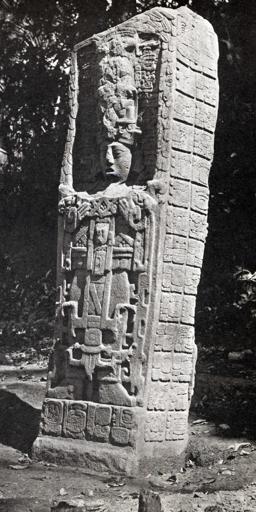 |
 |
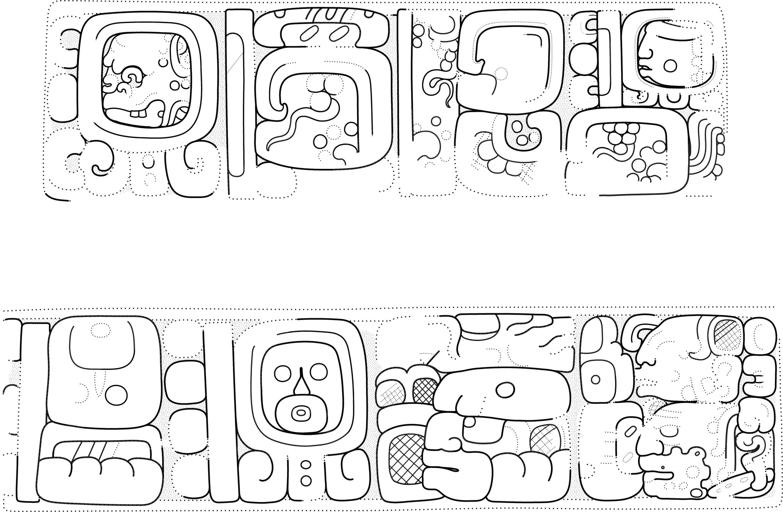
The basal text
The two basal texts are clearly to be understood as a unit, as is evident from their chronology. The reading begins with the basal register on the south side with the date 1 Eb 5 Yax (9.17.4.10.12, August 4, 7751)), which is connected by a distance number of eight days (VIII-la-ta) on the north side to the Tzolk’in day 9 Ajaw (9.17.4.11.0, August 12, 775 (1)). The chronology of these basal texts and their connection was already recognized by Sylvanus Morley (1937–38: 158–162) and Matthew Looper (2003: 166–67).
The first date is followed by a verb, which so far could not be read, and the two glyphs VI-AJAW TUUN-ni, “6 Ajaw Stone”. We know from Quirigua that the stelae of the site are named after the day of their erection. This is also true for Stela C whose date of erection falls on a day 6 Ajaw. Because the first sign in the verb shares similarities with the sign for stela, including the characteristic stone markings, Matthew Looper (2003: 166) already assumed that it must be a pre-dedication event for the monument.
The verb consists of three signs and is numerically transcribed as 1927st.[607bt:181br] according to the conventions used by our project (2) (Figure 3). The –ja suffix (Sign 181) indicates that it is a derived intransitive verb, most likely a passive form. The severely eroded sign in the center is not clearly visible in many earlier drawings, but detailed photographs leave little doubt that it is Sign 607, representing the syllable jo. The first sign, a rectangular shape with markings that identify the material and texture of the depicted rectangular object as “stone, rock”, has remained undeciphered. In his catalog of Maya hieroglyphs, Eric Thompson (1962:143) identified the sign in question as T529, WITZ. In the Macri-Looper catalog the sign appears as 1C5 (Macri and Looper 2003: 270), while in our catalog it is listed as 1927st. Macri and Looper describe the icon of the sign as a stela, and in their online database transcribe it as LAKAM-TUN-ja. However, the graph 1927st representing Sign 1927 is clearly different from the graphs representing the signs for WITZ and LAKAM which usually stand for the word “lakam tuun” for “stela”. Given the shape of the sign and the stone markings inside, the sign seems to be the icon for a dressed stone block, whereby the rectangular ashlar-shape distinguishes it as a piece of worked stone which contrasts the rounded shape of Graph 528st of Sign 528, TUUN, representing a generic stone or rock and rather focusing on the material. Based on the jo syllable, the first sign must be a logogram reading C-oj. The search for a transitive verb root that fits into this slot and refers to the working of stone led to the root t’oj, which in the relevant Mayan languages is a word for “pecking” and “chopping”:
Chontal: t’oje’ “picar” (Keller and Luciano G. 1997: 252)
Chol: t’oj “cortar (carne, piedra, madera)” (Aulie and Aulie 1978: 116)
Chorti‘: t’ojt‘-cha‘ „pit the surface [of] the grinding stone”; t’ojt’nib’ir “hammer” (Hull 2016: 434)
Tzotzil: t’ojey “peck” (Laughlin and Haviland 1988: 323)
Yucatec: t’oh “picar el molino, labrar y picar piedras”, t’oh tunich “proceso de dar forma a la piedra picándola para hacer utensilios (metates) y otros objetos”, t’ooh tunich “cantero, que labra piedras” (Barrera Vásquez 1980: 839)
Mopan: t’ooj “peck, knock”, t’oj “sonido de hacha” (Hofling 2011: 424-425)
Lacandon: t’oojik “knock on” (Hofling 2014: 352)
Itzaj: t’oj “sound of ax” (Hofling and Tesucun 1997: 619)
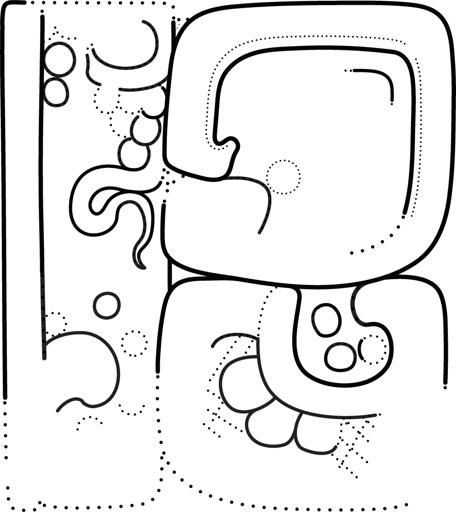
T’oj is a transitive verb in the relevant Mayan languages with the basic meaning of „to chop.“ Especially in Ch’orti‘ and Yucatec Mayan, it is clear that it refers to chopping and working stones. The origin of the root seems to be onomatopoetic. Semantically it is exactly the term that makes sense in this context. The graph icon of Sign 1927 itself appears to represent a stone ashlar set upright as a prototype of a worked stone and alluding to the basic shape of a stela as a large rectangular stone block. In this regard, T’OJ-jo-ja appears to be a plausible transcription for the sequence 1927st.[607bt:181br] on the north side of Stela C, leading us to the translation of the complete sentence as “the Six Ajaw Stone got chopped/pecked”.
The text now continues in the basal register of the south side with a distance number of eight days, which leads to the date 9 Ajaw (13 Yax). The corresponding predicate is written as u-tu-ta. Juun Ajaw and Yax Balam, the twin heroes of classic mythology, appear as the subjects of this short sentence. If we suppose that the prefixed sign u is the 3rd person pronoun, the root should be tut or tuut. This root occurs only a few times in the Maya written corpus and has not yet been adequately explained. The term u-tu-ta-li appears a total of three times in the long text of the Temple of the Inscriptions at Palenque. On the East Tablet, this combination occurs twice, in both cases in a context concerning the failure to deliver certain objects to the gods in the aftermath of Scroll Serpent’s raid on Palenque in the year 611 (Figure 4a, b). For this reason, the period ending of 9.9.0.0.0 could not be celebrated properly (Grube 1993: 5-6; Martin and Grube 2008: 161). In both cases the syntax of the texts is the same; they begin with the statement ma y-ak’wa „he does not give“, then follows the reference to u-tutal/u-tutil, and finally follows the name of the god who was not endowed with this tutal or tutil. In a similar context, u-tutal/u-tutil is found on the West Tablet of the Temple of the Inscriptions (Figure 4c). Here, however, the expression is not negated but follows a prophetic reference to twelve bak’tun periods that Pakal will live. The corresponding passage reads ya-AK‘-wa u-tu-ta-li CHAN-na K’UH, KAB-la K’UH „he gives tutal to the gods of heaven and earth“ (cf. Prager 2013: 434-439).
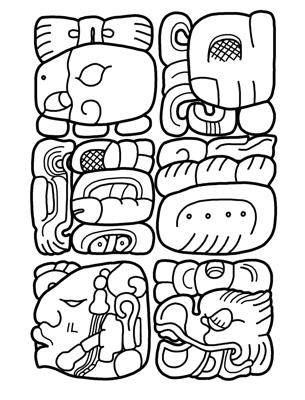 |
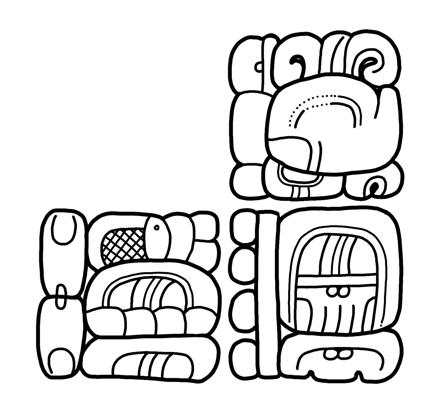 |
 |
Likewise, the expression u-tutal occurs several times in the Dresden Codex. In Dresden 11a tu-ta-li appears as an augural hieroglyph for God H (Figure 5). Another augural hieroglyph in the same phrase is ox wi’il „much abundance,“ suggesting that tutal must be an expression that also has positive connotations and that it is associated with gifts (cf. Houston 1997: 294-295). Furthermore, we see the hieroglyph tutal or u-tu-ta twice in the 4 x 91-day almanac, which stretches over the upper sections of pages 31-35a of the codex (Grube 2012: 190–196). On page 34a, u-tu-ta is associated with the listing of various food offerings that include waaj „tamales“ as well as another food and ul „atole“ (Figure 6). These food offerings are called u-tu-ta by Yax Chaak. This indicates that tut or tuut must be a generic term here for the previously mentioned offerings. The term tu-ta also occurs on p. 35a, but here the context remains opaque. It is probably a list of various offerings (Figure 7).



Another example for the syllabic combination u-tu-ta-li is attested on the ceramic vase Kerr 1196 (Figure 8). Here, it follows the hieroglyphs juun k’an, juun yax, which together represent a couplet meaning „abundance“ and „wealth“, which is still preserved in Postclassic sources from the highlands of Guatemala. All of these contexts suggest that u-tu-ta is a term associated with gifts, and that the hieroglyphs following the term name the addressees of those gifts. Despite this approximation to the meaning of this hieroglyph, the linguistic analysis is problematic. The preceding u is certainly to be understood as an ergative pronoun, so that the word root must be tut or tuut. In contemporary Yucatec ritual there is a ceremonial bread known as túuti waaj or xtúut waaj or simply xtúut (“pan ceremonial hecho de masa rellena de frijol cocido o pepita molida de calabaza” (Bastarrachea and Canto Rosado 2003: 238; Terán Contreras and Rasmussen 2008: 40; Villa Rojas 1945: 309). The origin of this word, however, remains opaque. A review of the other dictionaries has not been successful and has not revealed any obvious entries for tut or tuut as an offering. It is possible, however, that Chorti‘: tutur „covered up, stuffed up, plugged“ (Hull 2016: 420) is relevant (see also Boot 2009: 172). Another related term might be Yucatec: tutah “acabar o cerrar la tela” (Barrera Vásquez 1980: 827), if the gift is regarded as something that is wrapped and enclosed in a cover of cloth. The problem is that these are isolated dictionary lemmata which require considerable additional interpretation in order to fit the contexts required. For the moment, a general translation of u tut as “the gift of” seems to be a good working hypothesis to understand a Classic Mayan term that serves as a classificatory term for offerings.

The basal text on Stela C can be understood as an explicit reference to the carving of the monument 148 days before its erection. Only eight days after the carving, the monument seems to be dedicated or gifted to the hero twins, or the stela is described as the gift of the hero twins to the king K’ahk’ Tiliw. The Hero Twins are not only displayed as good hunters and blowgunners who appear together with the maize god and assist in his rebirth, but as role models for young men, they are also shown serving kings and delivering goods and offerings. On numerous ceramics, the Hero Twins are represented as obedient servants to Itzamnaaj, who provided the model of divine rule (Kerr 4548, 7727, 8665). In other common scenes, the Hero Twins deliver jewels and precious items to the maize god, leaving no doubt that in Classic Maya thinking, the Hero Twins were regarded as guardians of royal and divine wealth (Kerr 1004, 6979, 7268). In the case of Stela C, the stela named itself the “Six Ajaw Stone” seems to have been such a gift that was protected, curated and finally given to the current king by the Hero Twins.
The small basal text on Stela C is remarkable because references to the carving and production of the monuments are otherwise absent from Quirigua. The text provides us a glimpse at the process of sculpting, which started 148 days before the date recoded as the dedication date of the monument. The period of 148 days probably corresponds to the time that was needed for the entire production process of the monument, a quite plausible period of time for a group of stonemasons and sculptors to create a monument of this size and richness of sculptural detail in low relief. A very rough estimate of the sculptured surface of Stela C based on its height of 400 cm above ground (Sharer 1990: 30), an estimated average width of 140 cm and an estimated average thickness of about 90 cm yields 18.4 m2 of sculptured surface. Replicative experiments of carving complex sculptural motifs at Copan resulted in 29 person-days of 5 hours for 2.1 m2 of sculptured surface (cf. Abrams 1984; 1994: 44, Table 3, 45, Table 4). Applying this calculation on Stela C, this would result in 254,1 person-days, i.e. the time ONE person doing the sculpturing. In addition, there is the labor involved in quarrying and preparing the stone block, a task that is far less time-consuming than sculpting. However, since it can be safely assumed that more than 1 person worked on this stela, a total production time of 148 days for Stela C is realistic.
The text also informs us that Stela C, and probably also the contemporary Stela A, were regarded as precious gifts of the Hero Twins.
A note on sculptural techniques: t’oj versus ux
In terms of the Classic Mayan record with regard to terms relating to various techniques of working stone and other materials, the term discussed here is so far unique in the Classic Mayan corpus. It is in contrast to the numerous occurrences of the root ux represented by verbal phrases and verbal nouns (-uxul), as well as agentive titles (ajux(ul)) referring to the act of carving and engraving into stone, but also other materials (Houston 2016). The prominence of the latter may lie in the obviously more sophisticated and more prestigious act of creating imagery and inscriptions referred to by the root ux.
Both ux and t’oj refer to sculpturing, i.e., the removal of material from the object to be worked and given a shape, but the techniques and processes described by these terms differ completely.
The root ux and its derivates refer to a process of cutting away material with a sharp blade driven either by constant pressure of the hand on a blade or carving knife to work very soft materials, or by driving a sharp chisel with a mallet to work harder materials. This technique requires a high degree of motoric ability to control the force applied to the tool and moving the tool to create the intended design. Among the materials from which these tools were made are obsidian for fine incisions (cf. Melgar Tísoc and Solís Ciriaco 2005), and hard and tough fine-grained rocks like flint, chert, chloromelanite (= ”black jade”), and also jadeite for both hafted and non-hafted carving knives and chisels (cf. O’Kon 2012: 100–110; McKillop et al. 2019).
In contrast, the term t’oj describes a very simple technique applied during and after quarrying a stone block to give it a basic shape and to prepare its surface for subsequent smoothing and/or carving (Figure 10). This basic shaping of a quarried stone is achieved by pecking the surface of the stone with blunt force applied by hard blows perpendicular to the surface of the stone with a heavy hammer or hammer stone. The latter are ground stone tools –often re-used manos– usually consisting of hard granular rocks, including quartzite and granites from the Maya Mountains in Belize and volcanic rocks from the Guatemalan Highlands (cf. Clark et al. 2020; Delu 2007: 5, 7–8, 42), but hammerstones made from other hard rocks like chert or flint are attested as well (cf. Titmus and Woods 2002: 193-194). Such hammerstones are also attested as part of an ancient Maya sculptor’s tool set from findings at Group 4F-1 at Tikal (Haviland 1974: 495-496; 1985: 178; 2015: 83, 113, 116, Table 5.20). Pecking the surface of a stone with these tools fractures the stone’s surface and thereby softens and also pulverizes it, and thus allows for easier and faster removal of excess material (cf. Schneider and Osborne 1996:32, note 1). In addition to the basic shaping of the stone, pecking was also applied for sculpturing designs, particularly in the rather hard volcanic rocks of the Maya Highlands and the Pacific Coast. The microfractures caused by the pecking of a stone often go deeper below the intended surface used for the later carving which may result in characteristic spots on a non-weathered surface caused by the different reflective properties of fractured and non-fractured stone (Figure 9).
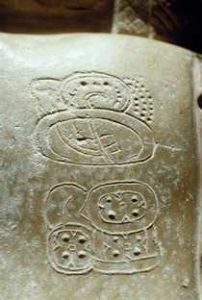 |
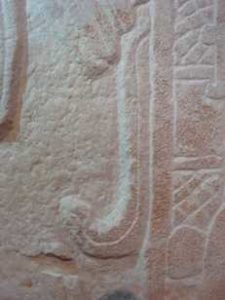 |
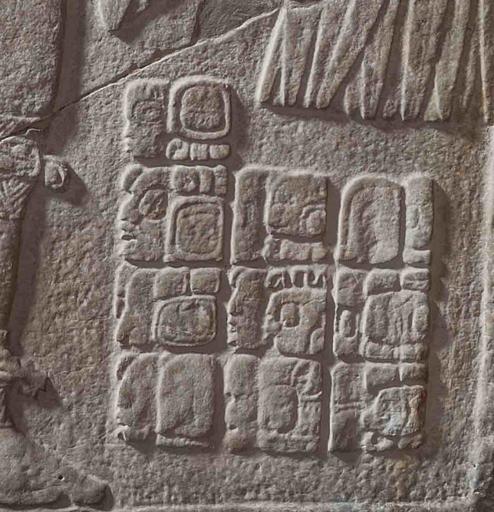
If such a pecked stone surface is exposed to the elements, this process results in a characteristic weathering pattern, enhancing the pitted texture caused by pecking (t’oj), particularly visible on worked limestone (Figure 11).
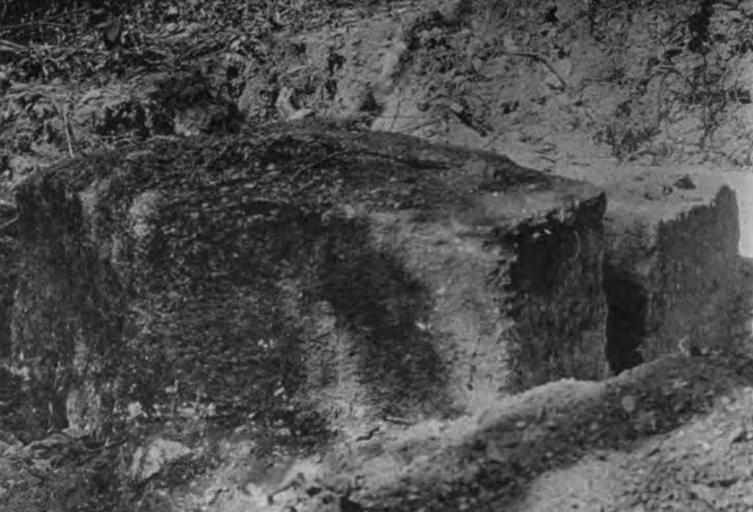
A technique attested by traces on the surface of numerous sculptured stone artefacts created by the ancient Maya, but so far only attested once by the verb t’oj in their written record, can now be added as another entry to the known Classic Mayan vocabulary of artistic techniques.
Acknowledgements
We thank Dmitri Beliaev and Sergei Vepretskii as well as Yuriy Polyukhovych for having shared their photographs of Quirigua Stela C.
References
Abrams, Elliot M.
1984 Replicative Experimentation at Copan, Honduras: Implications for Ancient Economic Specialization. Journal of New World Archaeology 6(2): 39-48.
1994 How the Maya Built Their World: Energetics and Ancient Architecture. University of Texas Press, Austin.
Ara, Domingo de
1986 [1571] Vocabulario de lengua Tzeldal segun el orden de Copanabastla. Edición de Mario Humberto Ruz. Fuentes para el Estudio de la Cultura Maya 4. Centro de Estudios Mayas, Universidad Nacional Autónoma de México, México, D.F.
Aulie, H. Wilbur, and Evelyn W. Aulie
1978 Diccionario ch’ol-español, español-ch’ol. Serie de Vocabularios y Diccionarios Indígenas, Mariano Silva y Aceves 21. Instituto Lingüístico de Verano, México, D.F.
Barrera Vásquez, Alfredo (ed.)
1980 Diccionario Maya-Cordemex, maya-español, español-maya. Ediciones Cordemex, Mérida.
Bastarrachea, Juan R., and Jorge Canto Rosado
2003 Diccionario maya popular (Maya-Español, Español-Maya). Instituto de Cultura de Yucatán, Mérida.
Boot, Erik
2009 The Updated Preliminary Classic Maya-English / English-Classic Maya Vocabulary of Hieroglyphic Readings. Mesoweb. Electronic Document, http://www.mesoweb.com/resources/vocabulary/Vocabulary-2009.01.pdf.
Clark, John E., Alejandro Pastrana, James C. Woods, and Bob Patten
2020 Hammerstones. Arqueología 60: 17–48. https://revistas.inah.gob.mx/index.php/arqueologia/article/download/17027/18220/36197
Delu, Antonina M.
2007 The Ground Stone Tools of Caye Coco, Belize. Occasional Publication 12. Institute for Mesoamerican Studies, The University at Albany, State University of New York, Albany.
Grube, Nikolai
1993 Palenque in the Maya World. In: Eighth Palenque Round Table, 1993, edited by Merle Greene Robertson, Martha J. Macri and Jan McHargue, 1–13. The Pre-Columbian Art Research Institute, San Francisco.
2012 Der Dresdner Maya-Kalender: Der vollständige Codex. Herder, Freiburg.
Haviland, William A.
1974 Occupational Specialization at Tikal, Guatemala: Stoneworking-Monument Carving. American Antiquity 39(3): 494-496.
1985 Excavations in Small Residential Groups of Tikal: Groups 4 F-1 and 4 F-2. Tikal Report 19. University Museum Monograph 58. The University Museum, University of Pennsylvania, Philadelphia.
2015 Excavations in Residential Areas of Tikal: Non-Elite Groups Without Shrines. Tikal Report 20B. University Museum Monograph 140. University of Pennsylvania Museum of Archaeology and Anthropology, Philadelphia.
Hofling, Charles Andrew
2011 Mopan Maya-Spanish-English Dictionary. The University of Utah Press, Salt Lake City.
Hofling, Charles Andrew, and Félix Fernando Tesucún
1997 Itzaj Maya-Spanish-English Dictionary. The University of Utah Press, Salt Lake City.
Houston, Stephen D.
1997 The Shifting Now: Aspect, Deixis and Narrative in Classic Maya Texts. American Anthropologist 99(2): 291–305.
2016 Crafting Credit. Authorship Among Classic Maya Painters and Sculptors. In Making Value, Making Meaning: Techné in the Pre-Columbian World, edited by Cathy L. Costin, 391–431. Dumbarton Oaks Research Library and Collection, Washington, D.C.
Hull, Kerry
2016 A Dictionary of Ch’orti’, Mayan-Spanish-English. The University of Utah Press, Salt Lake City.
Keller, Kathryn, and Plácido Luciano G.
1997 Diccionario chontal de Tabasco (mayense). Serie de Vocabularios y Diccionarios Indígenas “Mariano Silve y Aceves” 36. Summer Institute of Linguistics, Tucson.
Laughlin, Robert M., and John B. Haviland
1988 The Great Tzotzil Dictionary of Santo Domingo Zinacantán. Smithsonian Contributions to Anthropology 31. Smithsonian Institution Press, Washington, D.C.
Looper, Matthew G.
2003 Lightning Warrior: Maya Art and Kingship at Quirigua. University of Texas Press, Austin.
Macri, Martha, and Matthew G. Looper
2003 The New Catalog of Maya Hieroglyphs. University of Oklahoma Press, Norman.
Martin, Simon, and Nikolai Grube
2008 Chronicle of the Maya Kings and Queens. Thames & Hudson, London and New York.
Martin, Simon, and Joel Skidmore
2012 Exploring the 584286 Correlations Between the Maya and European Calendars. The PARI Journal 13(2): 3–16.
Maudslay, Alfred P.
1974 [1889-1902] Biologia Centrali-Americana. Contributions to the Knowledge of the Fauna and Flora of Mexico and Central America. Archaeology. Milpatron Publishing, New York [London].
McKillop, Heather, George Harlow, April Sievert, C. Wayne Smith, and Michael C. Wiemann
2019 Demystifying Jadeite: An Underwater Maya Discovery at Ek Way Nal, Belize. Antiquity 93(368): 502–518.
Melgar Tísoc, Emiliano Ricardo y Reyna Beatriz Solís Ciriaco
2005 Arqueología experimental lapidaria en el templo mayor de Tenochtitlan. Actualidades Arqueológicas 3: 24–31.
Morley, Sylvanus G.
1937-38 The Inscriptions of Peten. Carnegie Institution of Washington Publication 437. 5 Vols. Washington, D.C.
O’Kon, James A.
2012 The Lost Secrets of Maya Technology. The Career Press, Pompton Plains.
Prager, Christian M.
2013 Übernatürliche Akteure in der Klassischen Maya-Religion: Eine Untersuchung zu intrakultureller Variation und Stabilität am Beispiel des k’uh “Götter”-Konzepts in den religiösen Vorstellungen und Überzeugungen Klassischer Maya-Eliten (250 – 900 n. Chr.). Inaugural-Dissertation, Rheinische Friedrich-Wilhelms-Universität, Bonn.
Prager, Christian, and Sven Gronemeyer
2018 Neue Ergebnisse in der Erforschung der Graphemik und Graphetik des Klassischen Maya. In: Ägyptologische “Binsen”-Weisheiten III: Formen und Funktionen von Zeichenliste und Paläographie [Akademie der Wissenschaften und der Literatur, Abhandlungen der Geistes- und sozialwissenschaftlichen Klasse, 15], edited by Svenja A. Gülden, Kyra V. J. van der Moezel and Ursula Verhoeven-van Elsbergen, 135–181. Franz Steiner Verlag, Stuttgart.
Ruppert, Karl, and John H. Denison
1943 Archaeological Reconnaissance in Campeche, Quintana Roo, and Peten. Carnegie Institution of Washington Publication 543. Carnegie Institution, Washington, D.C.
Schneider, Joan S. and Richard H. Osborne
1996 A Model for the Production of Stone Mortars and Bowls. Pacific Coast Archaeological Society Quarterly 32(4):27–40. http://pcas.org/Vol32N4/324Schn.pdf
Sharer, Robert J.
1990 Quirigua: A Classic Maya Center and its Sculptures. Carolina Academic Press, Durham.
Terán Contreras, Silvia, and Christian H. Rasmussen
2008 Jinetes del cielo maya: Dioses y diosas de la lluvia en Xocén. Ediciones de la Universidad Autónoma de Yucatán, Mérida.
Titmus, Gene L., and James C. Woods
2002 Un estudio arqueológico y experimental de las canteras antiguas de Nakbe, Petén, Guatemala. In XV Simposio de Investigaciones Arqueológicas en Guatemala, 2001, edited by Juan Pedro Laporte, Héctor Escobedo, and Bárbara Arroyo, 188-201. Museo Nacional de Arqueología y Etnología, Guatemala.
Villa Rojas, Alfonso
1945 The Maya of East Central Quintana Roo. Carnegie Institution of Washington Publication 559. Carnegie Institution, Washington, D.C.
Footnotes
- Applying the 584,286 days correlation constant (Martin and Skidmore 2012)
- As part of our work on a new catalogue of Maya signs and their graphs, we are currently evaluating and revising Thompson’s Catalog of Maya Hieroglyphs (1962). We are critically scrutinizing his system with the help of his original grey cards and supplementing it with signs that were not included in Thompson’s original catalogue. Despite its known shortcomings and incompleteness, his catalogue is still regarded as the standard work for Maya epigraphers, which is why we adopt Thompson’s nomenclature while removing misclassifications and duplicates, merging graph variants under a common nomenclature, and adding new signs or allographs to the sign index in sequence, starting with the number 1500. Allographs are also further organized with the help of newly defined classification and systematization criteria, which we described in detail in Prager and Gronemeyer (2018). Basically, many graphs of Maya writing can be divided into two or more segments along their horizontal and vertical axes. These segmentation principles are designated by a two-letter code that is suffixed to the sign number. Revision of existing catalogues and their expansion, including a systematic index of all known allographs of each sign, will form the basis for our machine-readable text corpus of Classic Mayan.